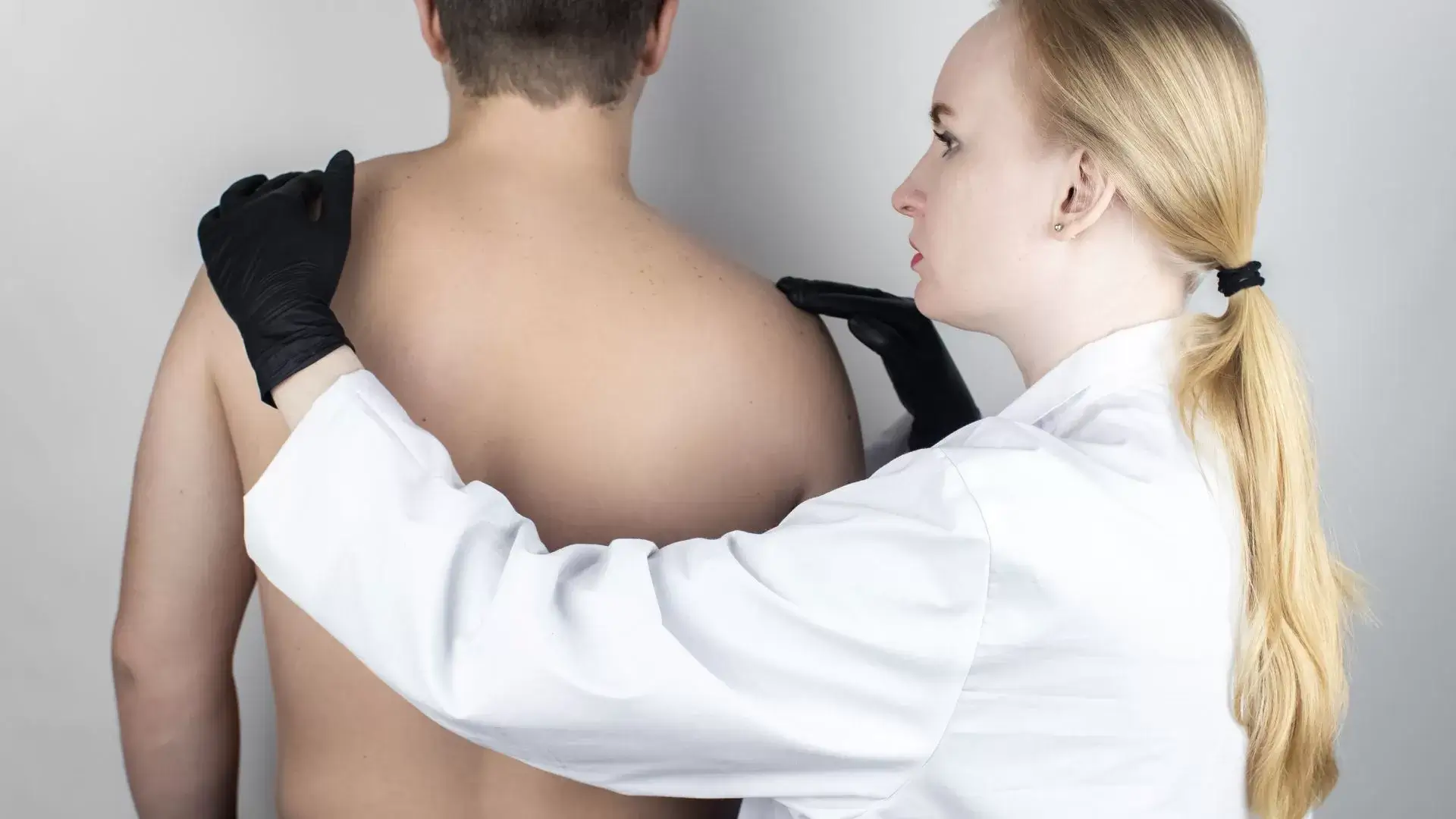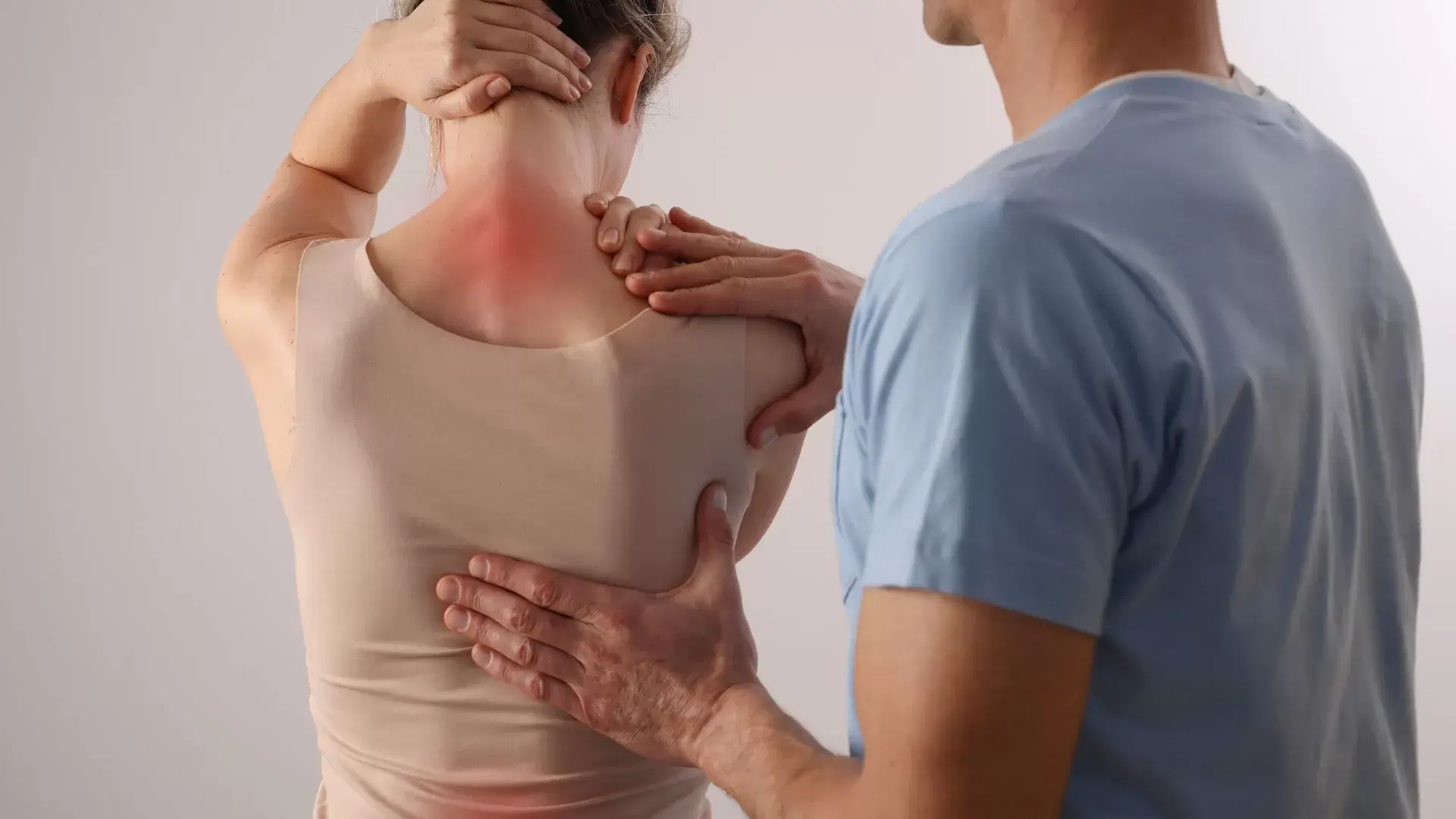If you’re seeking chiropractic care for lordosis in Mississauga, we’re here to help. Our Best Physiotherapist & Chiropractor in Mississauga specializes in treating lordosis by focusing on spinal alignment, core strengthening, and postural correction. We recognize the discomfort that comes with exaggerated spinal curvature, and we’re committed to providing personalized treatment plans tailored to your needs. Our holistic approach combines chiropractic adjustments with rehabilitative exercises to enhance spinal health and mobility. We also emphasize proactive strategies for maintaining your well-being. To discover how our services can support your journey to better spinal health, feel free to explore further options we provide.

At Mississauga Physio Chiro Clinic, we offer extensive physiotherapy and chiropractic services tailored to address lordosis and promote overall spinal health. Located at 1834 Lakeshore Rd W #6C, Mississauga, ON L5J 1J7, we recognize the challenges that come with lordosis symptoms, and we’re committed to providing effective lordosis treatment options.
Our approach includes spinal alignment therapy and postural correction, designed to improve spinal stability and enhance overall spine correction. By focusing on core strengthening, we help our patients build the necessary support to maintain a healthy spine. Our physiotherapy and chiropractic services work together to create a thorough plan that targets the underlying issues contributing to lordosis.
We believe in fostering a supportive environment where our patients feel empowered on their journey to better spinal health. Our team of skilled professionals is dedicated to guiding you through each step of your treatment, ensuring you receive personalized care that suits your specific needs.
If you’re experiencing the discomfort of lordosis symptoms, we invite you to visit us at our Oakville location and discover how our tailored services can help you achieve lasting relief and improved spinal health. Together, we can work towards a stronger, healthier spine.
Understanding lordosis requires us to explore the various causes and contributing factors that lead to this condition, which can considerably impact one’s posture and overall spinal health. Lordosis, particularly lumbar lordosis, refers to the natural inward curvature of the lower spine. However, when this curvature becomes excessive, known as hyperlordosis, it can result in postural misalignment and discomfort.
Several lordosis causes stem from muscle imbalances, where some muscles become tight while others weaken. For instance, an anterior pelvic tilt, often linked to poor posture, can exacerbate excessive lordosis. This tilt occurs when the pelvis tilts forward, increasing the spinal curvature and resulting in strain on the lower back.
Additionally, factors such as obesity, prolonged sitting, and lack of core strength contribute to this condition. By understanding these underlying causes, we can better address the issue of excessive lordosis. Through targeted chiropractic care and exercises, we can work towards restoring proper spinal curvature and alleviating discomfort. Ultimately, recognizing these contributing factors empowers us to take proactive steps in maintaining spinal health and improving posture.
Recognizing the signs and symptoms of lordosis is essential for early intervention and effective management of this condition. We should be aware that lordosis can manifest through noticeable changes in spinal alignment, particularly an exaggerated curve in the lower back. Individuals may experience discomfort or pain, especially in the lumbar region, which can be exacerbated by poor spinal posture or core instability.
In addition to lower back pain, we might notice spinal muscle tension, which can arise from the body compensating for abnormal spine curvature. Cervical lordosis, or changes in the neck’s curvature, can also contribute to overall discomfort. Identifying these signs early allows us to prioritize back pain relief and explore potential lordosis prevention strategies.
A thorough posture assessment can help us understand our spinal alignment and address any issues that may be contributing to lordosis. Through chiropractic adjustments, we can work towards restoring proper spinal alignment and alleviating symptoms. By recognizing these signs collectively, we empower ourselves to take proactive steps in managing lordosis effectively.
Chiropractic care plays an essential role in managing lordosis by employing targeted adjustments to restore spinal alignment and reduce discomfort. Through spinal manipulation, we can effectively address issues in the lumbar spine, alleviating lower back pain and promoting better posture.
One of the key aspects of our approach includes enhancing spinal flexibility, which is vital for those experiencing lordosis. By focusing on postural exercises, we help strengthen weak core muscles that often contribute to the condition. Improved core stability not only supports the spine but also encourages ergonomic posture, reducing the strain on surrounding muscles.
Additionally, spinal rehabilitation techniques are tailored to each individual’s needs, ensuring a thorough strategy for recovery. Our goal is to empower patients with knowledge and tools to manage their condition effectively. By integrating chiropractic care with lifestyle modifications, we can markedly improve the quality of life for those dealing with lordosis.

Accurate assessment of lordosis is essential for determining the most effective treatment plan, and various diagnostic tools and imaging techniques play an important role in this process. We typically start with a thorough physical examination to evaluate spinal alignment and identify any signs of spinal deviation or vertebral misalignment. This initial assessment helps us gauge spinal stability and dysfunction.
Imaging techniques, such as X-rays or MRIs, provide a clearer picture of the cervical and lumbar spine, allowing us to assess the degree of lordosis, including cases of hypolordosis. These images help us identify any underlying issues contributing to spinal instability or discomfort.
Additionally, we often recommend specific lumbar spine exercises tailored to improve spinal mobility and flexibility. These spinal flexibility exercises are essential in promoting proper posture and alleviating tension in the spine. By utilizing a combination of physical assessments and advanced imaging, we can develop a thorough treatment plan that addresses each patient’s unique needs, ensuring effective management of lordosis and fostering long-term spinal health.
After evaluating the degree of lordosis through physical assessments and imaging techniques, we can implement spinal adjustments aimed at restoring the spine’s natural curvature. These spinal adjustments are vital for improving spinal alignment and addressing any spinal joint dysfunction or facet joint dysfunction present.
By focusing on spinal biomechanics, we can enhance lumbar support, promoting a healthier posture. Our approach often includes pelvic tilt correction, which is fundamental in realigning the pelvis and reducing undue stress on the spine. Additionally, spinal decompression techniques can be used to alleviate nerve compression, providing relief from discomfort and enhancing mobility.
It’s important to note that while spinal adjustments are effective, we may also recommend complementary physical therapy for lordosis. This supports the adjustments and helps strengthen the surrounding muscles, further stabilizing the spine.
Together, we can work towards restoring your spine’s natural curvature, alleviating pain, and improving your overall quality of life. Our goal is to empower you with the knowledge and tools necessary for ideal spinal health. Through a tailored approach, we can help you achieve lasting results.
Addressing postural imbalances and pelvic misalignment is fundamental for achieving ideal spinal health and enhancing overall well-being. By focusing on spine alignment, we can help prevent issues such as neck pain and an exaggerated lumbar curve, which often arise from conditions like swayback posture. To support best spinal health, we recommend incorporating hip flexor stretching and hamstring stretching into your routine, as these exercises can alleviate tension and improve flexibility.
Additionally, strengthening exercises for lordosis play an essential role in promoting functional movement and stability. By targeting the core and lower back muscles, we can create better spinal support, reducing the risk of discomfort and injury. A posterior pelvic tilt may also be beneficial for some individuals, as it encourages a more neutral pelvic position and helps to counteract excessive curvature.
Through a combination of stretching, strengthening, and mindful movement, we can effectively address postural imbalances and pelvic misalignment. This holistic approach not only improves spine alignment but also contributes to enhanced overall health and well-being. Together, let’s work towards a healthier posture and a more balanced body.
To further enhance spinal health and alleviate discomfort, spinal decompression therapy offers an effective solution for pain and nerve relief, particularly for those struggling with conditions like lordosis. This therapy works by gently stretching the vertebral column, relieving spinal compression and providing space for the spinal nerves. For individuals experiencing spinal nerve impingement or spinal stenosis, decompression can considerably reduce pain and improve mobility.
In our practice, we often combine spinal decompression with physiotherapy for lordosis, focusing on muscle strengthening and stretching exercises for lordosis. These exercises not only support the spine but also help in correcting postural imbalances that contribute to discomfort. Additionally, we conduct gait analysis to assess walking patterns, which can reveal underlying issues affecting spinal health.
For patients dealing with degenerated disc disease, spinal decompression therapy can be particularly beneficial, as it promotes healing and disc regeneration. By integrating this therapy into our all-encompassing approach, we aim to provide lasting relief and improve overall spinal health. Together, we can work towards achieving a pain-free life and restoring functionality in your thoracic spine and beyond.

Chiropractic care plays an essential role in addressing swayback posture and enhancing spinal stability through targeted adjustments and personalized rehabilitation strategies. By focusing on correcting the alignment of the spine, we can alleviate issues related to tight hip flexors, weak glutes, and tight lower back muscles. These factors often contribute to lordosis and can exacerbate conditions like scoliosis or kyphosis.
Our approach includes specific chiropractic adjustments aimed at reducing vertebral compression and improving overall spinal function. Additionally, we incorporate cervical spine exercises to promote neck stability and alleviate tension that may arise from postural imbalances. For patients dealing with degenerative disc disease or spinal arthritis, tailored rehabilitation plans are vital. These plans focus on strengthening surrounding musculature and enhancing flexibility.
We believe in educating our patients about their posture and its implications. By addressing the root causes of swayback posture, we can help prevent future complications and improve overall quality of life. If you’re facing challenges related to swayback posture, don’t hesitate to reach out to us at 111-111-1111 for a consultation. Together, we’ll work toward a healthier spine and a more balanced body.
Muscle weakness and imbalances often contribute considerably to the development of lordosis, further complicating postural issues and overall spinal health. It is understood that when certain muscle groups become weak, others may compensate, leading to an uneven distribution of tension across the spine. This imbalance can exacerbate the curvature of the lower back, resulting in discomfort and potential long-term issues.
In our practice, we frequently observe that weak abdominal and gluteal muscles often fail to provide adequate support to the spine. Conversely, tight hip flexors and lower back muscles can pull the pelvis forward, increasing the lordotic curve. Addressing these weaknesses is essential for restoring proper posture and alleviating pain.
We emphasize the importance of identifying these imbalances through thorough assessments. By understanding how muscle weakness contributes to lordosis, we can tailor our chiropractic approaches to effectively target these concerns. Our goal is to support our patients in achieving a balanced muscular structure that promotes spinal alignment and overall well-being. In doing so, we pave the way for a more effective treatment plan, setting the foundation for improved posture and enhanced quality of life.
Incorporating targeted strength and flexibility exercises can greatly aid in correcting lordosis by promoting balanced muscle function and enhancing spinal alignment. By focusing on specific muscle groups, we can strengthen the core, glutes, and hamstrings while improving the flexibility of the hip flexors and lower back.
One effective exercise we can practice is the pelvic tilt, which helps to strengthen the abdominal muscles and reduce excessive curvature. We can also perform bridges to engage the glutes, further supporting the spine. Stretching exercises, like the child’s pose and hip flexor stretches, can improve flexibility in tight areas, contributing to better posture.
Additionally, incorporating yoga poses, such as the downward dog and cat-cow, can enhance both strength and flexibility while promoting mindfulness in our movements. By committing to a consistent routine of these exercises, we can work towards restoring proper spinal alignment and alleviating discomfort associated with lordosis.
It’s crucial to remember that we should consult with a chiropractor or qualified professional to guarantee we’re performing these exercises correctly and safely. Together, we can achieve a healthier spine and improved overall well-being.
To enhance our spinal health and address issues like lordosis, we should adopt postural and lifestyle modifications that promote better alignment and reduce strain on the back. First, maintaining proper posture while sitting, standing, and walking is essential. We can practice sitting with our feet flat on the ground and our back supported, ensuring our shoulders are relaxed and our head is aligned with our spine.
In addition to proper posture, we’ll benefit from regular breaks during prolonged sitting. Standing up, stretching, or walking around every hour can relieve tension and improve circulation. Incorporating ergonomic furniture, like chairs with lumbar support, can also make a significant difference.
Our daily activities play an important role, too. When lifting objects, we should bend our knees and keep the load close to our body to minimize strain on our back. Staying active through low-impact exercises, such as swimming or walking, will help maintain our spine’s flexibility and strength.
Chiropractic care offers a holistic approach to managing chronic back and neck pain, helping us regain mobility and improve our overall quality of life. By focusing on the alignment of the spine and musculoskeletal system, we can address the underlying causes of our discomfort rather than just masking the symptoms. Chiropractors utilize various techniques, including spinal adjustments, soft tissue therapy, and rehabilitative exercises, tailored to meet our specific needs.
One of the key benefits of chiropractic care is its non-invasive nature. We can often find relief without the need for medications or surgery, which can come with significant side effects and recovery times. Regular chiropractic adjustments can help reduce inflammation, enhance circulation, and promote healing, all of which contribute to alleviating chronic pain.
Moreover, chiropractors provide valuable education on maintaining proper posture and ergonomics, which are essential in preventing future pain episodes. They empower us with knowledge about our bodies and encourage us to take an active role in our health. By incorporating chiropractic care into our wellness routine, we can experience lasting relief and improved function, allowing us to engage fully in our daily activities and enjoy a better quality of life.
Integrating chiropractic care with physiotherapy can greatly enhance our recovery from lordosis, as both disciplines work together to improve spinal alignment and strengthen supporting muscle groups. Chiropractic adjustments focus on realigning the spine, helping to alleviate pain and restore proper function. Meanwhile, physiotherapy emphasizes rehabilitation through targeted exercises, which can increase flexibility, stability, and overall strength.
By combining these approaches, we can create a thorough treatment plan tailored to our specific needs. Our chiropractor will assess our spinal condition and make adjustments as needed, while our physiotherapist will design an exercise regimen that complements these adjustments. This synergy allows us to address both the symptoms and underlying causes of lordosis.
Additionally, working with both professionals guarantees we receive ongoing support and education throughout our recovery journey. They’ll guide us in maintaining proper posture and body mechanics, which are essential for long-term success. Together, chiropractic care and physiotherapy not only help alleviate discomfort but also empower us to take an active role in our healing process. As we commit to this collaborative approach, we can look forward to a healthier, more aligned spine and improved overall well-being.
Maintaining proper posture and engaging in regular exercise are essential proactive strategies for preventing lordosis and promoting overall spinal health. We should be mindful of our posture throughout daily activities, whether sitting at a desk, driving, or lifting objects. By keeping our spine aligned and our shoulders back, we can greatly reduce the risk of developing lordosis.
Incorporating core-strengthening exercises into our routines can also help us maintain spinal health. Activities like planks, bridges, and specific yoga poses strengthen the muscles that support our spine. We ought to aim for a balanced fitness routine that includes flexibility exercises, as they enhance our overall mobility and reduce tension in the back muscles.
Additionally, we shouldn’t underestimate the importance of ergonomic furniture. Using chairs that support our lower back and adjusting our workstation to promote a neutral spine can make a notable difference. Regular breaks from prolonged sitting are vital, too; standing and stretching periodically can alleviate tension.
When we’re facing challenges related to lordosis, booking a consultation with a chiropractor in Mississauga can provide us with personalized treatment options tailored to our specific needs. During our initial consultation, the chiropractor will conduct a thorough assessment, including our medical history, posture evaluation, and physical examination. This extensive approach allows them to understand the unique aspects of our condition.
After the evaluation, the chiropractor will discuss their findings with us, explaining how our lordosis may be affecting our overall health. They’ll outline a customized treatment plan that may include spinal adjustments, therapeutic exercises, and lifestyle modifications aimed at improving our spinal alignment and reducing discomfort.
It’s essential to remember that each person’s experience with lordosis is different, and our treatment should reflect that individuality. By working closely with a qualified chiropractor, we can develop a strategy that not only addresses our current symptoms but also promotes long-term spinal health. Contact us today!
As we explore treatment options for lordosis, it’s important to contemplate the vibrant community of Mississauga, where residents enjoy a blend of urban conveniences and natural beauty. This dynamic city, located just west of Toronto, boasts a diverse population and a rich cultural tapestry that enhances our quality of life.
Mississauga offers a range of amenities, including parks, shopping centers, and recreational facilities, making it an ideal place for families and individuals alike. The city’s extensive network of trails and green spaces encourages outdoor activities, which can be beneficial for those managing musculoskeletal issues like lordosis.
Moreover, Mississauga is home to a variety of healthcare professionals, including chiropractors who specialize in spinal health. These practitioners understand the unique challenges posed by conditions like lordosis and provide personalized care tailored to our needs.
As we engage with this supportive community, we’re reminded of the importance of maintaining our health and well-being. By seeking chiropractic care in Mississauga, we can better manage our lordosis and enjoy everything this vibrant city has to offer. Let’s embrace the journey to wellness together.

When it comes to chiropractic treatment for lordosis, we often find that the duration can vary based on individual needs and the severity of the condition. Typically, we can expect treatment to take anywhere from a few weeks to several months. We’ll work closely with our chiropractor to develop a personalized plan, ensuring we monitor progress and make adjustments as needed. Our commitment to consistent sessions can lead to effective results and improved spinal alignment.
When considering chiropractic adjustments for lordosis, we need to be aware of potential side effects. While many experience relief and improved mobility, some may encounter mild discomfort, soreness, or fatigue following adjustments. These effects are usually temporary and can be managed with proper care. It’s essential for us to communicate openly with our chiropractor about any concerns and monitor how our bodies respond to treatment, ensuring a safe and effective experience.
While chiropractic care can greatly improve lordosis, it might not completely correct it for everyone. We’ve seen that individual responses vary based on factors like severity, age, and overall health. Regular adjustments, combined with exercises and lifestyle changes, can help enhance spinal alignment and reduce discomfort. It’s important to approach treatment holistically, focusing on both immediate relief and long-term stability, ensuring we achieve the best possible outcomes together.
When we’re seeking a chiropractor for lordosis, we should prioritize their qualifications. It’s vital to look for a licensed professional with a degree in chiropractic care and specialized training in spinal conditions. Experience in treating lordosis specifically is also important, as well as membership in professional chiropractic associations. We shouldn’t hesitate to ask about their treatment approach and success stories, ensuring we feel confident and supported in our journey to better spinal health.
When considering chiropractic care for children with lordosis, we believe it’s crucial to prioritize their safety and comfort. Many studies suggest that chiropractic adjustments can be safe and beneficial for children, promoting better spinal alignment and overall health. However, we should always consult with a qualified healthcare provider to guarantee the treatment is appropriate. Open communication with the chiropractor about our child’s specific needs will help create a safe and effective care plan.
Reach out to us today to book an appointment or learn more about our services. Our friendly team is here to answer your questions and help you take the first step toward improved health and wellness.
(647) 372-1209

At our Mississauga Physio Chiro Clinic, we are dedicated to providing personalized care that addresses the root cause of your discomfort. With a team of experienced physiotherapists and chiropractors, we focus on restoring your mobility, relieving pain, and enhancing your overall well-being.